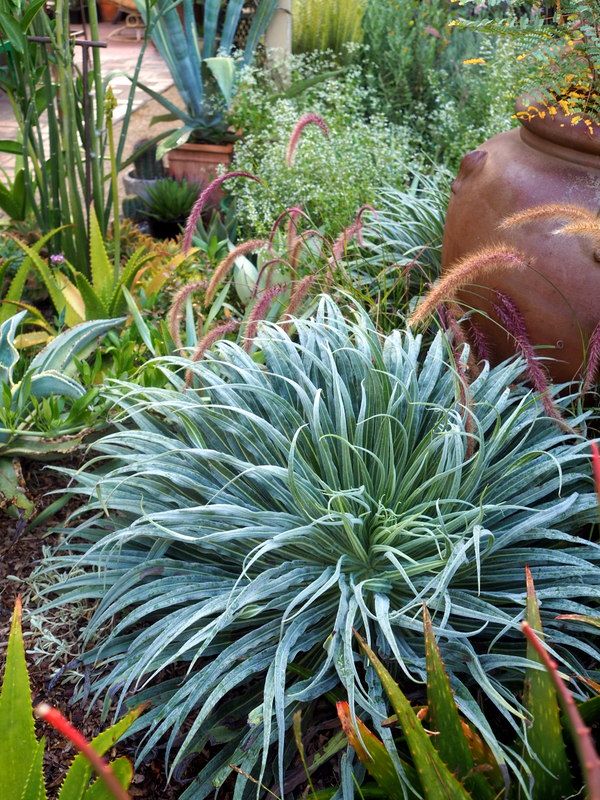
I know I mostly talk about plants with a micro focus trained on their singularly gorgeous attributes, like Echium wildpretii above, but with this post I’m going to pull out of that narrow focus a bit and go wider.
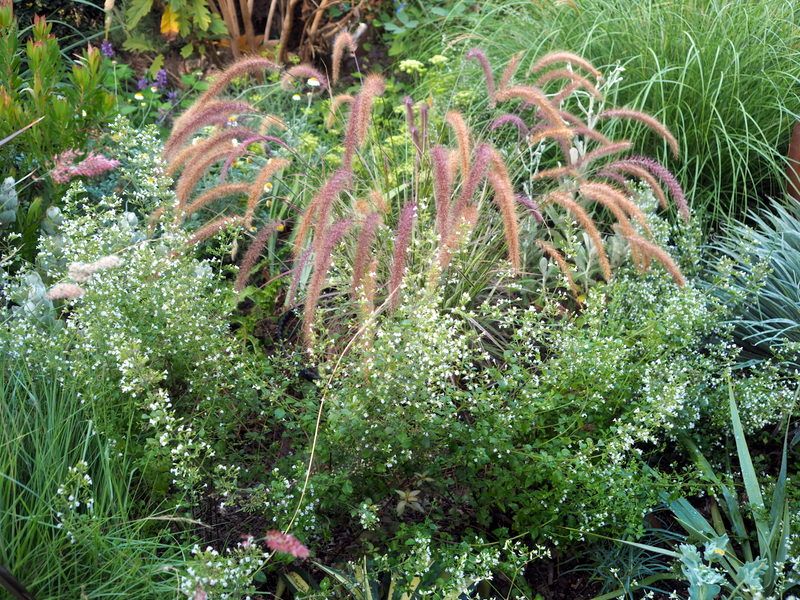
Normally I’d want to tell you more about my new crush, Pennisetum ‘Cherry Sparkler,’ and my hopes for it being the one, a mediumish-size grass whose girth doesn’t exceed that of a small car in a single season. But it’s nearly mid-August, and we’ve all been through a lot of summer. A lot of summer and smoke, to crib from Tennessee Williams. And it only makes sense to plan for increasingly hotter and longer summers. (I just read about more horrific wildfires, this time in Montana, in today’s NYT.) But do you ever consider how your plant and design choices will impact the temperature inside your home? Maybe it’s me, but I don’t see this subject broached very often. Over the past 28 years, I can’t help but observe how choices in my own garden have impacted our little bungalow’s livability, especially during the crucible of summer. As of today, we have yet to install air conditioning, and this summer we’ve been reasonably comfortable. We talk about this all the time, and for a brief moment this summer a portable AC was purchased but ultimately returned. If we had triple digits for weeks on end, I might rethink the AC issue, but for now I’m willing to let the power flow to those much more in need of it. And we are only a mile from the Pacific Ocean, so definitely YMMV.

Some of the main cooling and shade features are built, not planted, starting off the back porch of our 1,120 square-foot house. The pergola attached to the house has two levels, with the topmost level extending as a roof over the little concrete porch and shading the kitchen windows forward of the porch. The ladder leads to the berth above the laundry shed, where you can always catch a breeze and great views of birds and other wildlife shenanigans. The striped fabric at the far end is hung for both privacy and shade from morning sun. There’s usually a dog-eared New Yorker stuffed under the cushions. The entire structure brings critical shade to this south side of the house. Shade can be accomplished with trees, of course, but for a small area so close to the house, a pergola affords complete control, without danger of falling branches or root intrusion. We’ve experienced both falling branches and trees and much prefer the relative permanence and stability of the pergola.
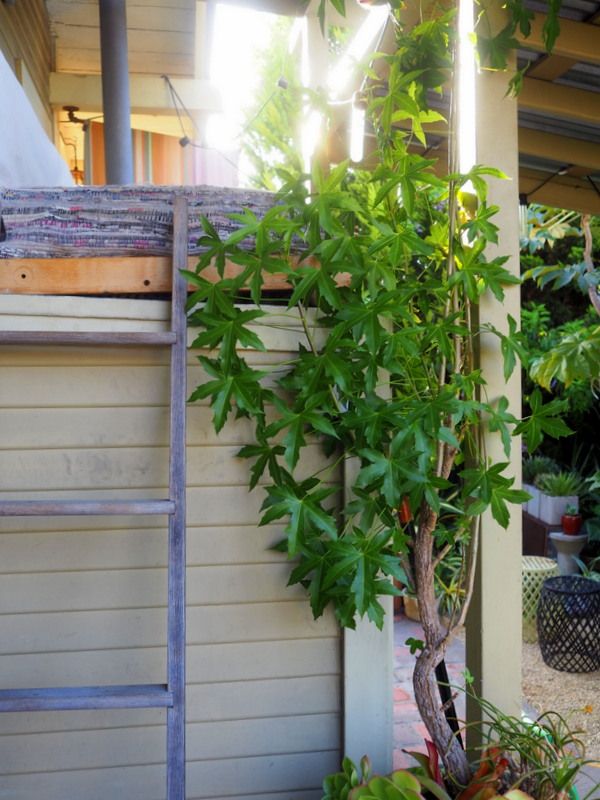
I do have to put the big picture briefly on pause to point out how well the potted Cussonia natalensis is doing this year. Old habits die hard.
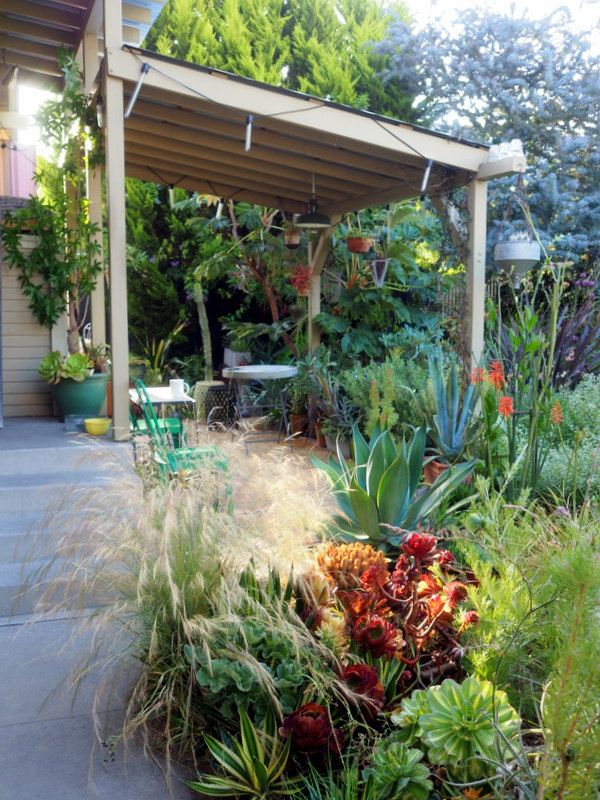
Pulling back again to show how the planting starts in earnest just feet away from the house and back porch, but that’s just my preference. Maybe you’re more of a Thomas Church devotee (“Gardens Are For People“), and would prefer less plants and more open space for entertaining, and I agree with that to an extent. But lots of plants do result in an incredible cooling effect. So that’s a trade-off everyone has to cipher out for themselves, but I’d just keep in mind the warmer summers to come (and all the cool plants out there waiting to be grown).
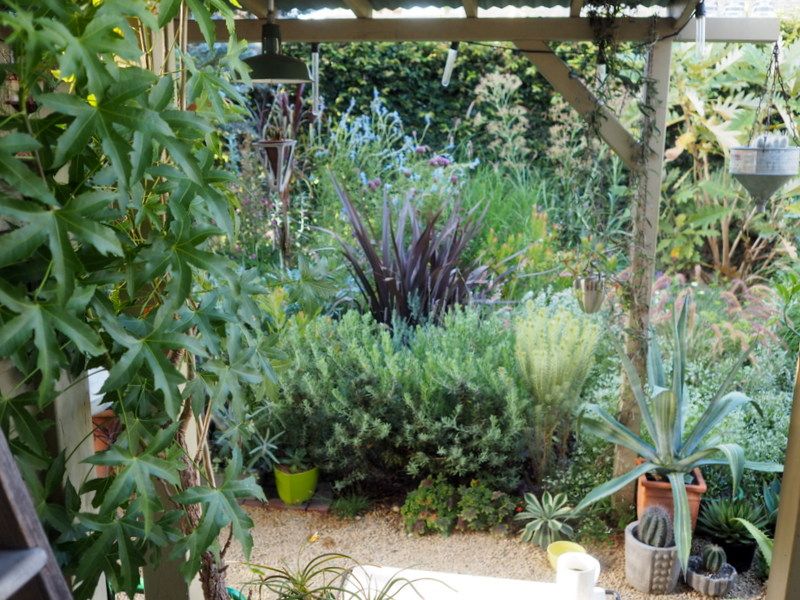
Succulents and small evergreen shrubs like Eremophila glabra and lavender surround the pergola, and then the planting gets crazier with summer ephemerals such as Salvia uliginosa way in the back, where their winter absence won’t be as noticeable.
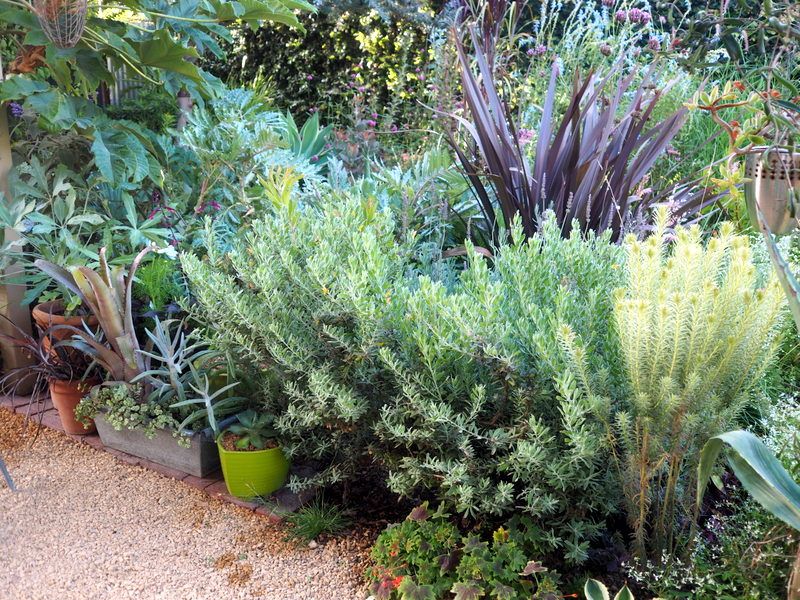
My garden philosophy aims at being the girl with the most cake, with as much year-round inspiration and stimulation as I can squeeze out of a small garden. And I’d be the first to admit that I probably live in a constant state of over-stimulation.
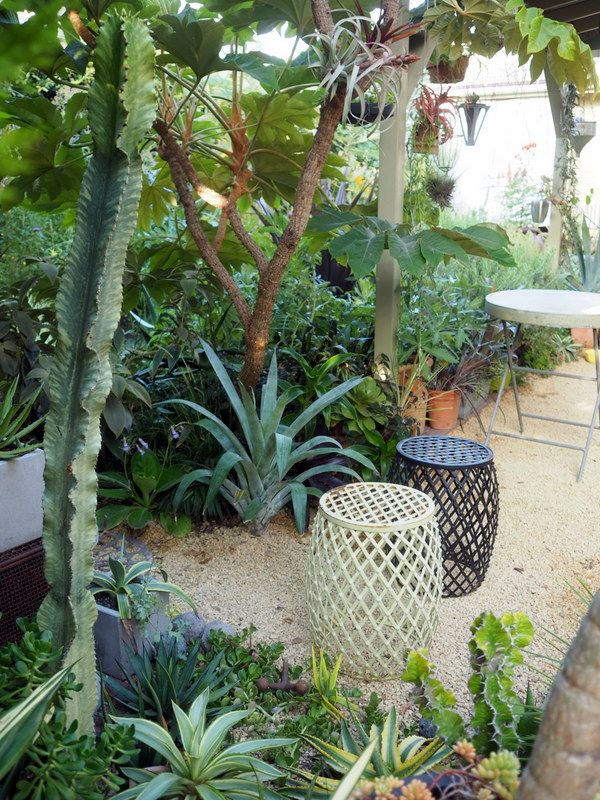
Looking west under the pergola. In a couple weeks we’re hosting an engagement party for my youngest son, so I’m trying out the two metal drums as a temporary barrier to keep kids from getting lost or speared by an agave in the jungle.
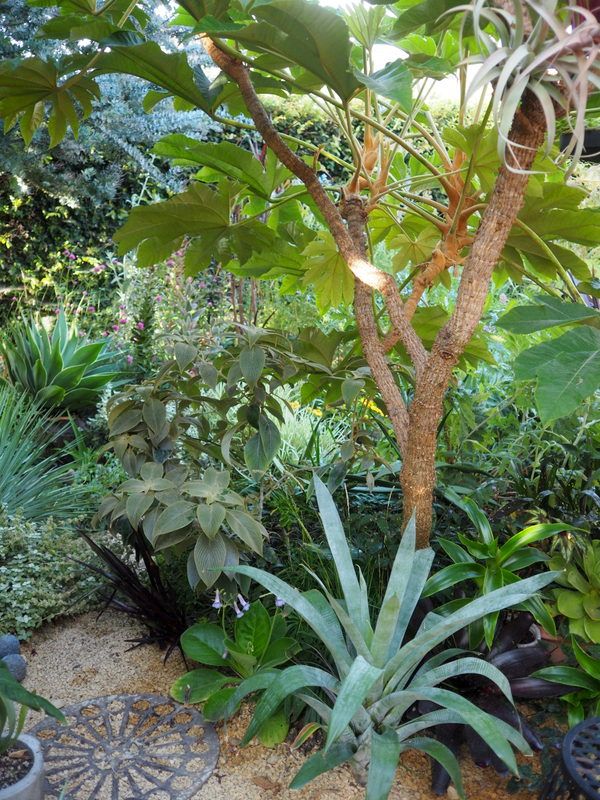
Dramatic and flamboyant rosettes like bromeliads and agaves are big on presence and light on water. The high shade provided by the tetrapanax are perfect conditions for bromeliads in summer. In winter many of the bromeliads get moved into full sun.

The lemon cypresses and acacia are providing increasingly more shade at this eastern end, and some things may have to consequently be shifted around, but the positives so outweigh the negatives. That’s Tanglefoot smeared halfway up the acacia’s trunk, btw.
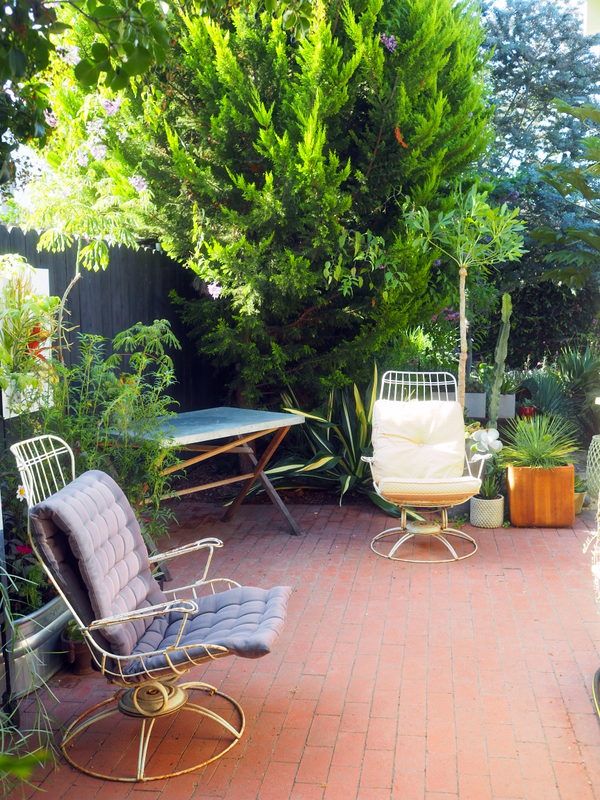
Continuing under the pergola toward the east leads to this brick-on-sand laid patio. The lemon cypresses were planted with privacy in mind, as was the Acacia baileyana ‘Purpurea,’ to their right, but the cooling effect from all three has been a huge side benefit. The cypresses are approximately 20 feet tall now and may reach 30 feet. (I’m thinking of setting up the bar for the party on the table in the corner.)

The bricks lead further north into the “East Wing,” which is uncharacteristically empty for the moment and in the midst of getting cleaned and ready for the engagement party tables and benches. The branches in the top right foreground are the Chinese Fringe Tree, which sits roughly in the middle on the east side of the house, and the trees beyond the Dutch-door gate are the parkway jacarandas. The adjacent neighbor’s choice of Queen palms along the eastern boundary has added more high shade and privacy for us without the dreaded “dungeon” effect. Once you start thinking about shade, you realize how many kinds there are: light shade, deep shade, dappled, etc.

Another structure that cools the house is the bath house/bird house off our bedroom. Around March we remove the glass panes and use only screens until around November, and the sliders from the bedroom to the bath house are constantly kept open to cool the bedroom through just the screen door. This side is so narrow that I can’t get a full-on photo. I begged for a bath house, Marty complied and built it single-handedly, and then I let parakeets take over. (Just because I am an unstable person, and Marty has learned to graciously live with that fact.) But neither of us realized at the outset what a cooling effect the structure would have on the main house, basically functioning like a screened-in sleeping porch.

The view out the bedroom, through the bath house to the east fence, through the canopy of the Chinese Fringe Tree, Chionanthus retusus, now forming its inky berries that will end up as navy blue bird shite splashed over plants, bricks, etc., but it’s easily hosed off, and I love hearing the birds (and squirrels) hopping around in the tree. You can see where the parakeets chewed into the wood above the roller blind.

Another structural change, admittedly a very low-effort one, was opening up this little sunroom off the kitchen on the west side. It’s been a revelation in air flow dynamics, and I’m convinced it’s now the lungs of the house. It’s always been used as a bedroom and was just this year finally emptied out and turned into a little reading room. In contrast to the privacy requirements of previous occupants, doors and windows have been flung open, and a screen door has been added to the doorway that leads to the porch off the driveway. Opening its doors and windows is now part of the morning ritual, along with making the coffee, feeding the cat, turning off the porch lights.
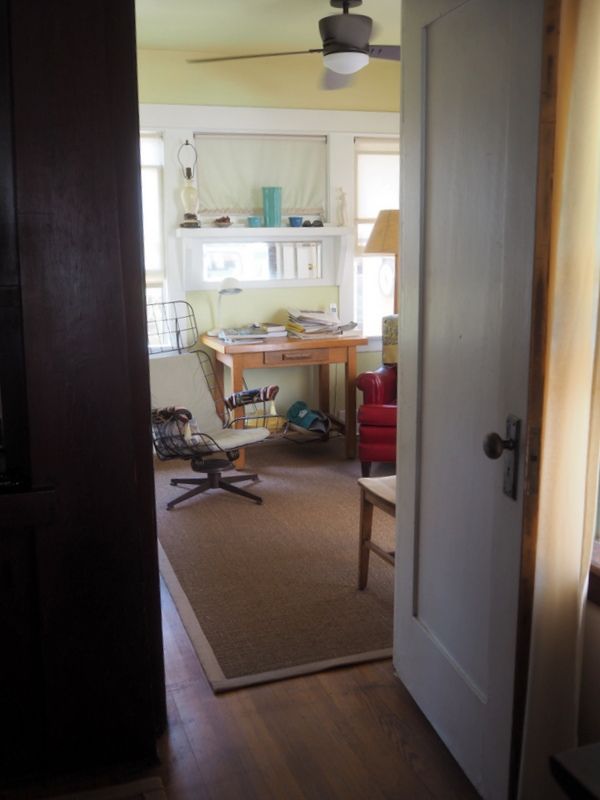
This door from the main house into the little sunroom has always been shut, too, again because privacy for its revolving teenage occupants was paramount. (I do wish I’d cleaned up a bit before photos.) Now I love to sit here and feel the cool air pour in off the garden in the evening and mix with cross-currents of ventilation coming from elsewhere in the house. The bungalow builders were masters at maximizing cross-currents, but it’s rare that their original intentions remain relevant as the original footprint is fiddled with by subsequent owners. The trick now for us is to keep the old sash-weight, double-hung windows in working order so the air can flow in from all directions. It’s a lot like taking care of an old wooden boat, and the floors creak just about as much too. (This article in Curbed discusses similar cooling and cross-flow strategies built into the old “shotgun shacks” of the South: “One of the most effective forms of air circulation is a ‘cross draft,’ an interior breeze that forms when two openings in a building -— windows, doors, and the like -— align.”)

“The idea of cooling a house in hot climates is nothing new—ancient Egypt used courtyards to promote air flow through buildings,” says Jonathan Hogg, associate at Ferguson & Shamamian Architects. “Providing air circulation is simply essential to summertime relief.” — Curbed, “How Houses Were Cooled Before Air Conditioning.”
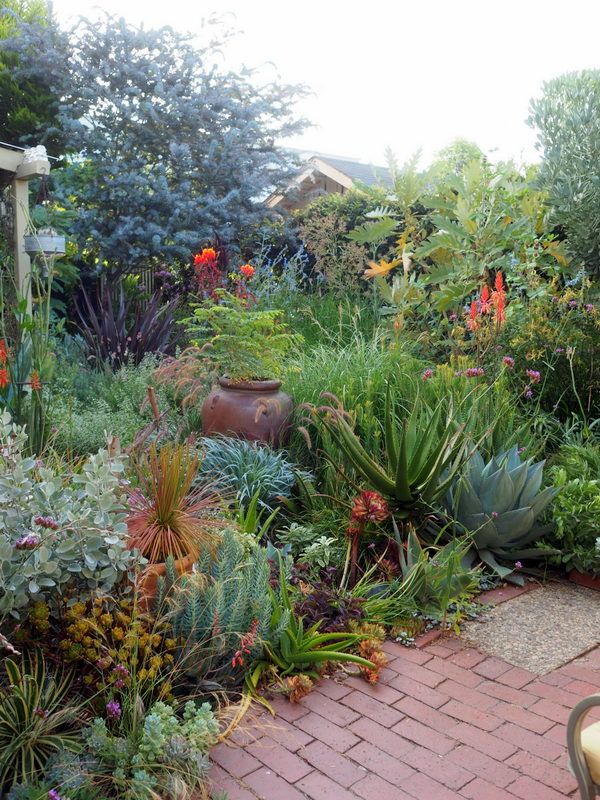
The view of the garden directly outside the reading room windows, the brick walkway about 6 feet across, leading to the office (half of the former garage).
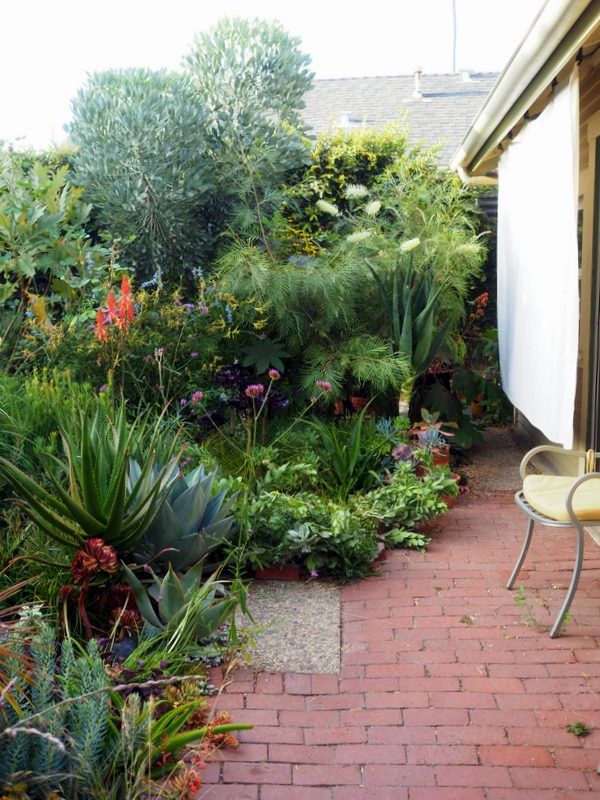
Possibly overplanted just a bit, but this is peak summer after all.

Just wide enough for a couple chairs and a table. The canvas painter’s drop cloth tarps are a low-tech hack for seasonal shade requirements. In summer the morning sun is directed blindingly on the doorway.
For brevity’s sake (ha!), I’ve limited this post to the back garden. The west side of the house is all driveway and workshop areas, partly concrete with some porous brick-on-sand areas, and we use overhead tarps here, too, in summer for shade when working on projects. The long, narrow, north-facing front garden is shaded by the parkway jacarandas. It is privacy-hedged by some shabby box on the north and ‘Little Ollie’s,’ dwarf olives, on the east. The Pearl Acacia has grown into an enormous shrub on the northwest corner of the house from all the cutting back it’s received to keep it from encroaching on the driveway, and I love the privacy and shade it gives the front porch and living room windows.
To sum it up, keeping the house cool is going to be an increasingly important consideration when planning the garden, and you might as well approach it directly, in contrast to our rather indirect, circuitous approach over the past 28 years.
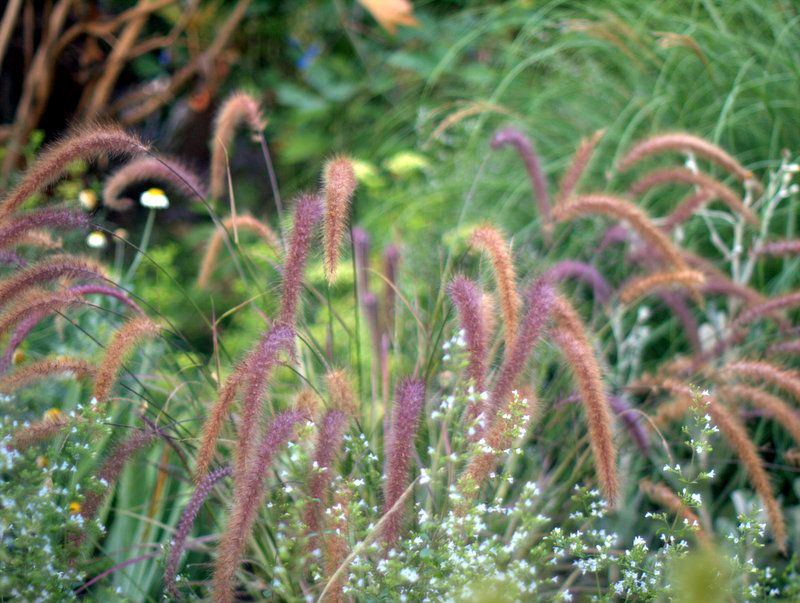

Always hungry for wide shots of your garden, plus you upped the thrill by including indoor photos as well!
I feel a little silly that we here in Portland have central a/c while you in SoCal do not. However we definitely do not have a well designed little bungalow, with cooling cross breezes. Whomever came up with the idea of corner windows on the west facing side of a house was not a smart designer. Plus there is zero overhang of the roof, so no shade there. Anyway… hope the engagement party is fun for all, with no damage to the garden…
I love seeing all the angles of your garden, all the shade plants and considerations. Your thinking is so sophisticated–I hope to be able to plan my future shade that way…in the blazing inland-SD sun! Thank you for this beautiful post…I’m sure it will be a lovely party! -Holly
You’ve done a masterful job of maximizing your natural and home-constructed strategies to keep things cool. Our current location is a good 10 degrees warmer than our former beach city location on average so we’re glad the house came with AC, even if it’s an old, clunky system. The surrounding trees help a lot, and were one of the reasons I was so incensed by my former neighbors insistence that we take one after another down to improve her view. With her gone, more trees and extra-large shrubs will creep in. A roof extension on the south side helps a lot but we don’t get the good cross-breezes you do as the house was constructed with virtually no windows on the front/west side.
Best wishes with the engagement party prep!!!
Where I am, the only increased trend in summer temperatures is to overnight lows in deep urban conditions, or if one leaves out the 1950’s and mid-1990’s from the record. But we have much more heat and sun than all but your interior valleys.
What the happy medium is on shading and plant density, my balance is not liked by those who don’t care how much water and limited plant palette a forest in the desert requires…and not liked by those who criticize my using more than one tree every 100 feet or more. Just can’t win, but I won’t stop seeking a happy medium of water conservation and heat mitigation…and good looks!
Your garden’s balance sure works for your locale, where you have the ability to use denser coverage with more humidity and mildness than we have.
Nice place. Nice pots too and the garden is not overplanted, just clearly well loved and utterly gorgeous. Our summers are defined by blistering heat and increasingly higher humidity. Don’t what you can do about the latter other than whinge. One thing that has worked for us in our soon to be renovated dilapidated wreck of a bungalow is an inherited massive Rosa banksia ‘Lutea.’ It smothers a generous portion of our tin roof and I’ll be removing it when I rebuild, but the principle will be applied to as much of the new roof as it is botanically possible to smother. Top of the list is vitis coignetiae and Rosa ‘Kiftsgate.’ Sod the guttering!
I love seeing wide shots of your garden and home. All that shade looks wonderful. Sadly we have no shade around the house. My parents are resistant to any large shrubs or small trees too close to the house or patio, and it will take them years of complaining and procrastinating before they do anything in the way of constructing shade. We have air conditioning, but one would think they’d want to save energy (and money) by investing in some shade to cool the house.
Wonderful garden, and a terrific, important post. There aren’t many SoCal gardening topics as fundamental as planting strategies to mitigate the heat. Wish I could make this required reading for anyone thinking of replacing a front garden with a heat sink of crushed rock. I love David’s “happy medium of water conservation and heat mitigation… and good looks” — your home and garden are proof it can be done.
[is proud not to have used “throwing shade” in this comment]
@Loree, I was checking in on the recent PNW heat wave and saw that 30% of Seattle doesn’t have AC, whereas 70% of Portland does, so you’re not alone. Every summer I’ve visited Portland was hot! I think the one of the hottest days of my life was spent at Cistus way before the Fling.
@Holly, I’m so glad you found something useful, since it wasn’t a very scientific analysis!
@Kris, you have so many more variables to consider, not to mention uncooperative neighbors!
@David, those are all good points. And another factor is air flow. Some of the meditt plants hate being crowded, and then my soil goes on the attack.
@Ross, we seem to be getting increasingly humid too. I thought growing up we experienced a “dry heat” — not the case anymore. Best of luck with the renov.
@Evan, we’re extremely termite-nervous here, so plants are kept away from the house too. In such cases pergolas and other structures are invaluable.
@Luisa, yes, what self-restraint, you should be proud! So nice to see you Saturday for our picnic with the peacocks!
Very interesting run down of cooling methods you used. We prefer natural cooling to A/C, the cost of electricity completely aside. Fresh air feels better. Here it has been a matter of trying different things, and finding multiple small solutions that eventually add up to a major increase in comfort. Exterior shades, the right combination of open windows and fans, a skylight that opens to let out heat, and a ceiling fan added this summer has made a big difference–I may not even dread next summer now.
Where plants are concerned, my neighborhood has the added complication of fire danger–the local Fire Authority advises the less vegetation you have within 10 feet of the house, the more likely they’d be able to save the house in a wildfire. Local code also means no eaves or overhangs that are a fire threat, but keep sun out of the windows. So the garden is still pretty hot, though the oak tree 25′ from the house is growing.
Here’s hoping you have a great party for your son!
What a treat to see wide shots of your gorgeous garden! So many great plants all looking healthy and happy! You’ve utilized some impressive cooling strategies! Although we live in a much cooler climate, our 100 year old house has great natural cooling ability. The thought of A.C. has never crossed my mind.